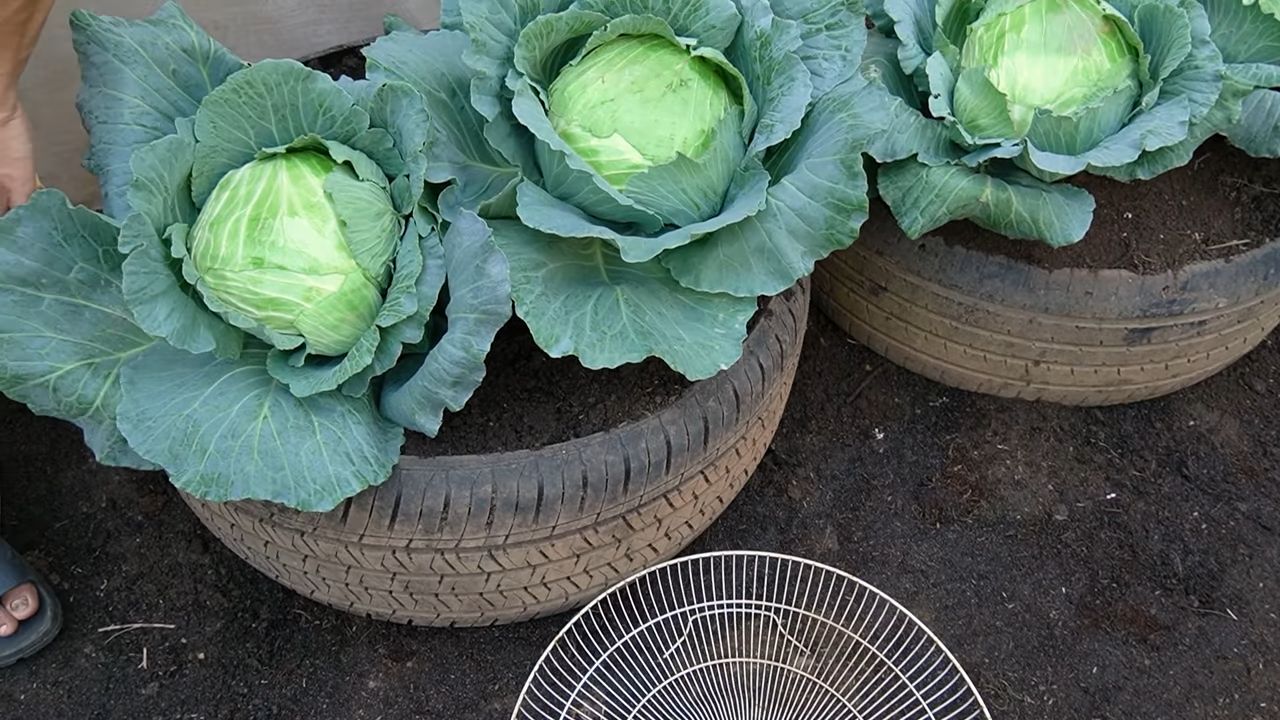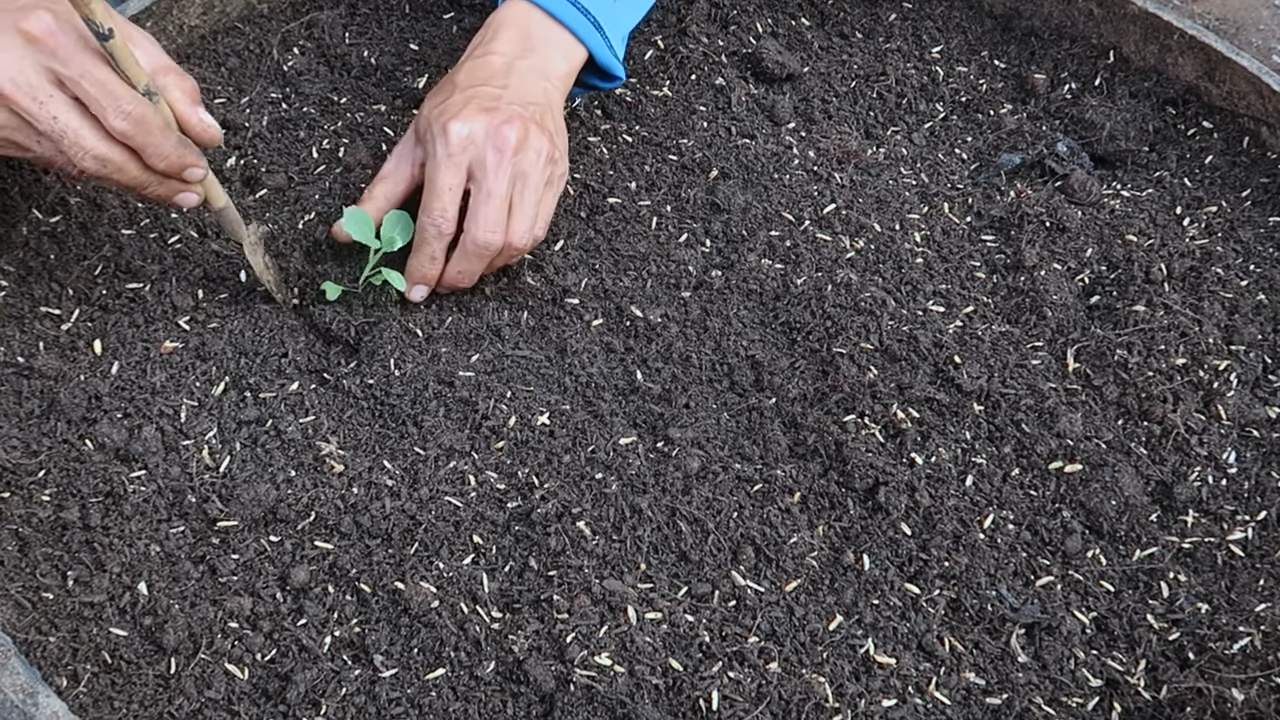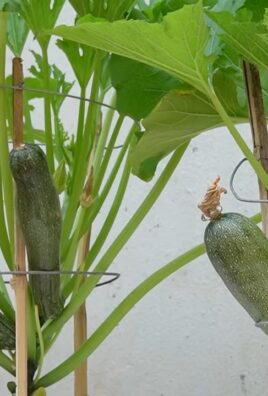Grow Cabbage at Home Easily and unlock the secrets to fresh, flavorful harvests right in your backyard! Have you ever dreamed of strolling through your garden, plucking a crisp, vibrant cabbage straight from the earth, and transforming it into a delicious meal? Well, dream no more! This DIY guide is your passport to cabbage-growing success, even if you’re a complete beginner.
Cabbage, a humble yet versatile vegetable, boasts a rich history, dating back to ancient times. From its origins in the Mediterranean, it has journeyed across continents, becoming a staple in countless cuisines. Cultures worldwide have embraced cabbage for its nutritional value and adaptability, using it in everything from sauerkraut and kimchi to hearty stews and vibrant salads. But why rely on store-bought cabbage when you can cultivate your own, bursting with freshness and flavor?
In today’s world, where we’re increasingly conscious of where our food comes from, growing your own vegetables offers a sense of control and connection to nature. Plus, let’s be honest, store-bought produce often lacks the vibrant taste of homegrown goodness. This DIY guide will provide you with simple, effective tricks and hacks to grow cabbage at home easily, saving you money, reducing your carbon footprint, and ensuring a supply of fresh, healthy vegetables for your family. I’m excited to share these tips with you!

Growing Cabbage at Home: A Beginner’s Guide
Hey there, fellow gardening enthusiasts! Ever dreamt of harvesting your own crisp, flavorful cabbage right from your backyard? Well, dream no more! Growing cabbage at home is surprisingly easy, even for beginners. I’m going to walk you through everything you need to know, from choosing the right variety to dealing with pesky pests. Let’s get started!
Choosing Your Cabbage Variety
First things first, you need to decide what kind of cabbage you want to grow. There are tons of options, each with its own unique flavor and growing requirements. Here are a few popular choices:
* Green Cabbage: This is your classic, everyday cabbage. It’s versatile and great for coleslaw, soups, and roasting.
* Red Cabbage: Adds a beautiful pop of color to your garden and dishes. It has a slightly peppery flavor and is perfect for pickling.
* Savoy Cabbage: Known for its crinkled leaves and mild, sweet flavor. It’s delicious in stir-fries and stuffed cabbage rolls.
* Napa Cabbage: Also known as Chinese cabbage, it has a milder flavor and more tender leaves than other varieties. It’s a staple in Asian cuisine.
Consider your climate and growing season when making your choice. Some varieties are better suited for warmer climates, while others thrive in cooler temperatures. Check the seed packet or plant label for specific recommendations.
Preparing Your Garden Bed
Cabbage needs a sunny spot with well-drained soil. Aim for at least 6 hours of direct sunlight per day. Before planting, it’s crucial to prepare your garden bed properly.
* Soil Testing: I highly recommend testing your soil to determine its pH level and nutrient content. Cabbage prefers a slightly acidic soil with a pH between 6.0 and 7.0. You can purchase a soil testing kit at most garden centers.
* Amending the Soil: Based on your soil test results, you may need to amend the soil with compost, aged manure, or other organic matter. This will improve drainage, fertility, and overall soil health. I usually add a generous amount of compost to my cabbage bed.
* Tilling or Digging: Loosen the soil to a depth of at least 12 inches. This will allow the cabbage roots to penetrate easily and access nutrients. You can use a tiller or simply dig with a shovel.
* Adding Fertilizer: Cabbage is a heavy feeder, so it needs plenty of nutrients. Incorporate a balanced fertilizer into the soil before planting. Look for a fertilizer with a ratio of 10-10-10 or 14-14-14.
Starting Cabbage Seeds Indoors (Optional)
While you can direct sow cabbage seeds in the garden, starting them indoors gives you a head start, especially in areas with short growing seasons.
1. Sowing the Seeds: Fill seed trays or small pots with a seed-starting mix. Sow the seeds about 录 inch deep and gently water them.
2. Providing Light and Warmth: Place the seed trays in a warm, sunny location or under grow lights. Cabbage seeds need warmth to germinate.
3. Watering Regularly: Keep the soil consistently moist, but not soggy.
4. Thinning Seedlings: Once the seedlings have developed a few true leaves, thin them out, leaving only the strongest seedling in each pot.
5. Hardening Off: Before transplanting the seedlings outdoors, you need to harden them off. This means gradually exposing them to outdoor conditions over a period of 7-10 days. Start by placing them in a sheltered location for a few hours each day, gradually increasing the amount of time they spend outdoors.
Transplanting Cabbage Seedlings or Direct Sowing
Once your seedlings are hardened off or if you’re direct sowing, it’s time to get them in the ground!
1. Choosing the Right Time: Transplant cabbage seedlings outdoors 2-3 weeks before the last expected frost in spring or 6-8 weeks before the first expected frost in fall. For direct sowing, plant seeds in early spring or late summer.
2. Spacing: Space cabbage plants 12-24 inches apart, depending on the variety. Larger varieties need more space.
3. Planting Depth: Dig a hole that is slightly larger than the root ball of the seedling. Gently remove the seedling from the pot and place it in the hole. Make sure the top of the root ball is level with the soil surface. For direct sowing, plant seeds about 陆 inch deep.
4. Watering Thoroughly: After planting, water the cabbage plants thoroughly. This will help them settle in and establish their roots.
5. Mulching: Apply a layer of mulch around the cabbage plants. This will help retain moisture, suppress weeds, and regulate soil temperature. I like to use straw or shredded leaves.
Caring for Your Cabbage Plants
Now that your cabbage plants are in the ground, it’s time to provide them with the care they need to thrive.
* Watering: Cabbage needs consistent moisture, especially during hot, dry weather. Water deeply and regularly, aiming for about 1 inch of water per week.
* Fertilizing: Fertilize your cabbage plants every 2-3 weeks with a balanced fertilizer. You can also side-dress them with compost or aged manure.
* Weeding: Keep the garden bed free of weeds. Weeds compete with cabbage plants for nutrients and water.
* Pest Control: Cabbage is susceptible to several pests, including cabbage worms, aphids, and flea beetles. I’ll cover pest control in more detail in the next section.
Dealing with Pests and Diseases
Unfortunately, cabbage plants are a favorite snack for several pests. Here’s how to deal with them:
* Cabbage Worms: These green caterpillars can quickly devour cabbage leaves. Handpicking them off the plants is an effective method, especially for small infestations. You can also use Bacillus thuringiensis (Bt), a natural insecticide that is safe for humans and pets.
* Aphids: These tiny insects suck the sap from cabbage leaves, causing them to curl and yellow. Spraying the plants with a strong stream of water can dislodge aphids. You can also use insecticidal soap or neem oil.
* Flea Beetles: These small, jumping beetles can create tiny holes in cabbage leaves. Covering the plants with row covers can prevent flea beetles from reaching them. You can also use insecticidal soap or diatomaceous earth.
* Cabbage Root Maggots: These pests attack the roots of cabbage plants, causing them to wilt and die. Preventative measures are key. Use row covers to prevent the adult flies from laying eggs near the plants. You can also use diatomaceous earth around the base of the plants.
In addition to pests, cabbage can also be affected by diseases, such as black rot and clubroot. Choose disease-resistant varieties and practice good garden hygiene to prevent these problems.
Harvesting Your Cabbage
The moment you’ve been waiting for! Harvesting your own homegrown cabbage is incredibly rewarding.
1. Knowing When to Harvest: Cabbage is ready to harvest when the head is firm and solid. The size of the head will vary depending on the variety.
2. Harvesting Technique: Use a sharp knife to cut the cabbage head from the stem. Leave a few outer leaves on the stem to protect it from pests and diseases.
3. Storing Your Cabbage: Store cabbage in a cool, dry place. It can last for several weeks in the refrigerator.
Enjoying Your Homegrown Cabbage
Now that you’ve harvested your cabbage, it’s time to enjoy it! Cabbage is incredibly versatile and can be used in a variety of dishes. Here are a few ideas:
* Coleslaw: A classic summer side dish.
* Cabbage Soup: A hearty and comforting soup.
* Stuffed Cabbage Rolls: A delicious and satisfying meal.
* Roasted Cabbage: A simple and flavorful side dish.
* Sauerkraut: Fermented cabbage that is packed with probiotics.
Growing cabbage at home is a fun and rewarding experience. With a little bit of planning and effort, you can enjoy fresh, flavorful cabbage all season long. Happy gardening!

Conclusion
So, there you have it! Growing cabbage at home, far from being an intimidating agricultural feat, is surprisingly accessible and rewarding. We’ve walked you through the process, from seed to harvest, highlighting the key steps and offering insights to ensure your success. But why should you dedicate your precious time and garden space to this endeavor?
The answer is multifaceted. First and foremost, the taste of homegrown cabbage is simply unparalleled. Forget the bland, often waxed varieties you find in the supermarket. Homegrown cabbage boasts a crisp, fresh flavor that bursts with natural sweetness. Imagine the satisfaction of serving a coleslaw made entirely from ingredients you nurtured yourself, or adding freshly shredded cabbage to your soups and stir-fries, knowing exactly where it came from and how it was grown.
Beyond the superior taste, growing your own cabbage offers significant cost savings. Think about it: those heads of cabbage at the grocery store add up, especially if you’re a regular consumer. By investing a little time and effort upfront, you can enjoy a continuous supply of fresh cabbage throughout the growing season, significantly reducing your grocery bill.
Furthermore, growing cabbage at home is an incredibly sustainable practice. You’re reducing your carbon footprint by eliminating the transportation and packaging associated with commercially grown produce. You also have complete control over the inputs, allowing you to avoid harmful pesticides and herbicides and embrace organic gardening practices. This is especially important if you are concerned about the environmental impact of your food choices.
But the benefits don’t stop there. Gardening is a fantastic stress reliever. The simple act of nurturing plants, getting your hands dirty, and watching your efforts bear fruit (or, in this case, cabbage!) can be incredibly therapeutic. It’s a chance to connect with nature, disconnect from the digital world, and find a sense of peace and accomplishment.
Ready to take your cabbage growing to the next level? Consider these variations:
* Experiment with different varieties: From the classic green cabbage to the vibrant red cabbage and the delicately flavored Savoy cabbage, there’s a whole world of cabbage varieties to explore. Each offers a unique taste and texture, allowing you to diversify your culinary creations.
* Try succession planting: By planting new cabbage seedlings every few weeks, you can ensure a continuous harvest throughout the growing season. This is a great way to maximize your yield and avoid having all your cabbage mature at once.
* Companion planting: Cabbage thrives when planted alongside certain other vegetables and herbs. Consider planting dill, chamomile, or rosemary nearby to deter pests and attract beneficial insects.
Growing cabbage at home is more than just a gardening project; it’s an investment in your health, your wallet, and the environment. It’s a chance to connect with nature, learn new skills, and enjoy the unparalleled taste of homegrown produce. So, grab your seeds, prepare your soil, and get ready to embark on this rewarding journey.
We’re confident that you’ll be amazed by the results. Don’t be afraid to experiment, learn from your mistakes, and most importantly, have fun! And once you’ve harvested your first head of homegrown cabbage, we encourage you to share your experience with us. Post photos of your garden, share your favorite cabbage recipes, and let us know what you’ve learned along the way. Together, we can create a community of passionate home gardeners who are dedicated to growing their own food and living a more sustainable lifestyle. So, what are you waiting for? Start growing cabbage at home today!
Frequently Asked Questions (FAQ)
1. What is the best time of year to plant cabbage?
The best time to plant cabbage depends on your climate and the specific variety you’re growing. Generally, cabbage is a cool-season crop, meaning it thrives in temperatures between 60掳F and 70掳F (15掳C and 21掳C). For spring crops, start seeds indoors 6-8 weeks before the last expected frost. Transplant seedlings outdoors 2-3 weeks before the last frost. For fall crops, start seeds indoors in mid-summer and transplant seedlings outdoors in late summer or early fall. Check your local frost dates and the specific recommendations for your chosen cabbage variety for the most accurate timing.
2. How much sunlight does cabbage need?
Cabbage needs at least 6 hours of direct sunlight per day to thrive. Choose a planting location that receives full sun for optimal growth and head development. If you live in a particularly hot climate, some afternoon shade can be beneficial to prevent the leaves from scorching.
3. What kind of soil is best for growing cabbage?
Cabbage prefers well-drained, fertile soil that is rich in organic matter. The ideal soil pH is between 6.0 and 7.0. Before planting, amend your soil with compost, aged manure, or other organic materials to improve drainage, fertility, and water retention. A soil test can help you determine the specific nutrient needs of your soil.
4. How often should I water cabbage?
Cabbage needs consistent moisture to thrive. Water deeply and regularly, especially during dry periods. Aim to keep the soil consistently moist but not waterlogged. Mulching around the plants can help retain moisture and suppress weeds. A good rule of thumb is to water when the top inch of soil feels dry to the touch.
5. What are some common pests and diseases that affect cabbage?
Cabbage is susceptible to several pests and diseases, including cabbage worms, cabbage loopers, aphids, flea beetles, and clubroot. Regularly inspect your plants for signs of infestation or disease. Use organic pest control methods, such as handpicking pests, using insecticidal soap, or applying Bacillus thuringiensis (Bt), to control pests. To prevent diseases, practice crop rotation, ensure good drainage, and avoid overcrowding plants.
6. How do I know when my cabbage is ready to harvest?
Cabbage is ready to harvest when the head is firm and solid to the touch. The size of the head will vary depending on the variety, but generally, a mature head will be about 6-8 inches in diameter. To harvest, use a sharp knife to cut the head from the stem, leaving a few outer leaves intact.
7. Can I grow cabbage in containers?
Yes, you can grow cabbage in containers, but you’ll need to choose a large container (at least 12 inches in diameter) and use a well-draining potting mix. Container-grown cabbage may require more frequent watering and fertilization than cabbage grown in the ground. Choose smaller cabbage varieties that are well-suited for container gardening.
8. What are some good companion plants for cabbage?
Good companion plants for cabbage include dill, chamomile, rosemary, thyme, onions, garlic, and marigolds. These plants can help deter pests, attract beneficial insects, and improve the overall health of your cabbage plants. Avoid planting cabbage near strawberries, tomatoes, or other members of the nightshade family, as they can compete for nutrients or attract similar pests and diseases.
9. How do I store harvested cabbage?
To store harvested cabbage, remove any damaged or yellowing outer leaves. Wrap the head in plastic wrap or place it in a plastic bag and store it in the refrigerator. Cabbage can typically be stored for several weeks in the refrigerator.
10. Can I grow cabbage from scraps?
While you can’t grow a full head of cabbage from scraps, you can regrow the root end to produce cabbage greens. Place the root end in a shallow dish of water, ensuring that the cut end is submerged. Place the dish in a sunny location and change the water regularly. After a few days, new leaves will begin to sprout from the root end. You can then transplant the root end into a pot of soil and continue to grow it for a supply of fresh cabbage greens. This is a fun and easy way to reduce food waste and enjoy a continuous supply of fresh greens.





Leave a Comment